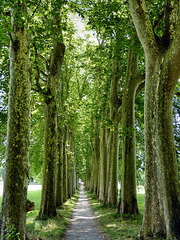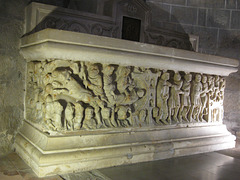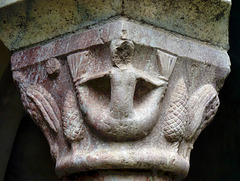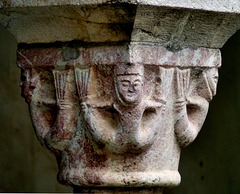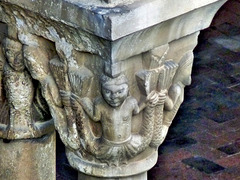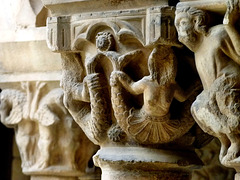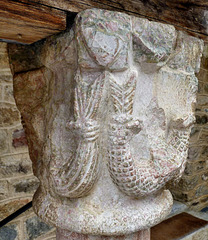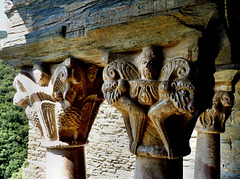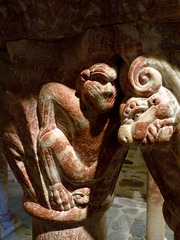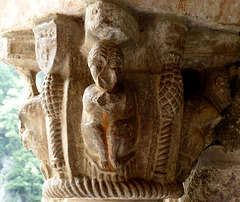
Languedoc-Roussillon -South
A collection of photos, that were taken in the departments Aude (11) and Pyrénées-Orientales (66) and parts of Hérault,
(34), the southern part of the Languedoc-Roussillon in France.
Near Montferrand
| |
|
Walking this wonderful avenue, I could already hear the boats on the Canal du Midi. They were waiting in front of the lock.
Montferrand - Riquet Obelisk
| |
|
Near Montferrand, after having passed the Minoterie de Naurouze, once a flour mill, this large obelisk dedicated to Pierre-Paul Riquet, the creator of the Canal du Midi, towers on a small hill. The obelisk was built by his heirs in 1827.
Here is what Wikipedia has about this genious engineer
en.wikipedia.org/wiki/Pierre-Paul_Riquet
fr.wikipedia.org/wiki/Pierre-Paul_Riquet
de.wikipedia.org/wiki/Pierre-Paul_Riquet
Two angels swinging the censers
| |
|
....the perspective he uses. There are these two angels, swinging incense burners. The angels are high up in the edges, pretty small,. You see the arms, with already larger hands, holding the tights, that go diagonal to the big censers. - And in the middle - out of the clouds - Gods blessing hand....
Here is an in-depth article about the Maître de Cabestany by Peter Hubert:
www.green-man-of-cercles.org/articles/the_maitre_de_cabes...
Saint Hilaire - Maitre de Cabestany
| |
|
......was the "Sarcophag of Saturnin" one of the masterpieces of the Maitre de Cabestany. Carved out of a single block of marble, it shows on the sides the life, death and resurrection of Saint Saturnin, first bishop of Toulouse, martyred....
Here is an in-depth article about the Maître de Cabestany by Peter Hubert:
www.green-man-of-cercles.org/articles/the_maitre_de_cabes...
Toulouges - Assomption de la Vierge
| |
|
A thousand years ago, Toulouges was an important village in the diocese of Elne. By now Toulouges is just another western suburb of Perpignan.
The "Église de l'Assomption de la Vierge" in Toulouges has an extraordenary southern portal, that is even more elaborate that one in Brouilla (see previous uploads). The left side of the portal is very weathered and partly lost. The tympanum is weathered as well and may depict St. Michael fighting the dragon.
The right side is still pretty complete. One of the two capitals (see previous upload) depicts a group centered around a beard pulling merman. Two mermaids flank the merman, while two bearded humans (?) peep over the fins. Though the carving style is comparably rough, all faces are very individual.
Toulouges - Assomption de la Vierge
| |
|
A thousand years ago, Toulouges was an important village in the diocese of Elne. By now Toulouges is just another western suburb of Perpignan.
The "Église de l'Assomption de la Vierge" in Toulouges has an extraordenary southern portal, that is even more elaborate that one in Brouilla (see previous uploads). The left side of the portal is very weathered and partly lost. The tympanum is weathered as well and may depict St. Michael fighting the dragon.
The right side is still pretty complete. These are the two capitals of the right side. To the left a mermaid and a bearded merman, to the right a pride of lions with plaited moustaches, similar to creatures in Saint-Michel-de-Cuxa. One of the lions is bent into the typical posture for the lions in the Roussillon.
The carving style is much rougher compared to Cuxa and Serrabone.
I was fascinated by the bearded merman - so next is a portrait of him.
Saint-Génis-des-Fontaines - Abbey
| |
|
Some Abbot Sentimir started to build an abbey here end of the 8th century. The abbey got looted and damaged by "heathens" (Marcel Durliat suspects Normans). From 981 on it was rebuilt by order of King Lothair of France, son of Louis IV of France (aka "Transmarinus"). The abbey slipped under the protection of the Counts of Roussillon and later of the Kings of Aragon. The church was enlarged and re-consecrated in 1153. Since 1088 the abbey was connected to Cluny in Burgundy.
The facade of the fromer abbey church has a white marble lintel over doors of the former abbey church depicting a theophany. For Doyen Marcel Durliat, author of "Roussilion roman", this relief marks the begin of Romanesque sculpturing within the Roussilion. Thanks to an inscription on that lintel (see previous uploads) it is known, that it was carved in 1019.
The Benedictian abbey existed upto the French Revolution, when the monks had to leave. The abbey church serves as a parish church "Saint Michel" since 1846.
Of course, the abbey had a cloister. It was built on the foundation of an older one - and was completed in 1271. This cloister was sold after the French Revolution to new owners, who had built there homes (and stables) into the structure.
Early 20th century some sly business men roamed the area looking for treasures. So - the polygonal fountain of the cloister was sold in 1913. Meanwhile the fountain can be admired in "The Cloisters" in New York. In 1924 some Paul Gouvert bought most of the cloister. Only one of the owners resisted. He had integrated the arcades into his living room. Mr. Gouvert must have had David Copperfield´s talents, as after a short while he gave two arcades (for free!) to the Louvre in Paris, sold one cloister to the Philadelphia Museum of Art and another one to the owner of a Renaissance chateau in Northern France.
In 1982 the owner of the chateau sold the cloister back. It got dismantled and brought back, where it joined the arcades from the Louvre two years later. The arcades in Philadelphia now got copied and in 1986 two side were completed. Only the owner of the southern corner still resisted to cooperate. Finally in 1994 the restauration was completed and since then it is open to the public. I learned that by now only the former chapter-house of the abbey is still a private living room.
The artistic style of the capitals is very rough (for mid 13th century), - the stories, symbols, icons are mystic. Obviously the many workshops having existed in the area (Saint-Michel-de-Cuxa, Espira-de-l'Agly, Elne, Villefranche-de-Conflent, Prieuré de Serrabone) a century ago, had given up business or moved on.
Just like in nearby Elne (10kms) rhere are many mermaids in Saint-Génis-des-Fontaines. The maids seen here are way clumsier than their slender relatives in Elne. But just like them, they have attracted vandals. The relationship between mermaids and vandals is not yet fully researched. Didn´t Sigmund Freud, the father of psychoanalysis, say anything about that? This mermaid, flanked by pine cones and birds (or sirens), lost the face.
Saint-Génis-des-Fontaines - Abbey
| |
|
|
Some Abbot Sentimir started to build an abbey here end of the 8th century. The abbey got looted and damaged by "heathens" (Marcel Durliat suspects Normans). From 981 on it was rebuilt by order of King Lothair of France, son of Louis IV of France (aka "Transmarinus"). The abbey slipped under the protection of the Counts of Roussillon and later of the Kings of Aragon. The church was enlarged and re-consecrated in 1153. Since 1088 the abbey was connected to Cluny in Burgundy.
The facade of the fromer abbey church has a white marble lintel over doors of the former abbey church depicting a theophany. For Doyen Marcel Durliat, author of "Roussilion roman", this relief marks the begin of Romanesque sculpturing within the Roussilion. Thanks to an inscription on that lintel (see previous uploads) it is known, that it was carved in 1019.
The Benedictian abbey existed upto the French Revolution, when the monks had to leave. The abbey church serves as a parish church "Saint Michel" since 1846.
Of course, the abbey had a cloister. It was built on the foundation of an older one - and was completed in 1271. This cloister was sold after the French Revolution to new owners, who had built there homes (and stables) into the structure.
Early 20th century some sly business men roamed the area looking for treasures. So - the polygonal fountain of the cloister was sold in 1913. Meanwhile the fountain can be admired in "The Cloisters" in New York. In 1924 some Paul Gouvert bought most of the cloister. Only one of the owners resisted. He had integrated the arcades into his living room. Mr. Gouvert must have had David Copperfield´s talents, as after a short while he gave two arcades (for free!) to the Louvre in Paris, sold one cloister to the Philadelphia Museum of Art and another one to the owner of a Renaissance chateau in Northern France.
In 1982 the owner of the chateau sold the cloister back. It got dismantled and brought back, where it joined the arcades from the Louvre two years later. The arcades in Philadelphia now got copied and in 1986 two side were completed. Only the owner of the southern corner still resisted to cooperate. Finally in 1994 the restauration was completed and since then it is open to the public. I learned that by now only the former chapter-house of the abbey is still a private living room.
The artistic style of the capitals is very rough (for mid 13th century), - the stories, symbols, icons are mystic. Obviously the many workshops having existed in the area (Saint-Michel-de-Cuxa, Espira-de-l'Agly, Elne, Villefranche-de-Conflent, Prieuré de Serrabone) a century ago, had given up business or moved on.
Just like in nearby Elne (10kms) here are many mermaids. The maids seen here are way clumsier than their slender relatives in Elne. But just like them, they have attracted vandals. The relationship between mermaids and vandals is not yet fully researched. Didn´t Sigmund Freud, the father of psychoanalysis, say anything about that? This one was pretty lucky, as only the nose got lost. It paid, to wear a protective helmet!
Elne - Cathedral
| |
|
later Hannibal camped here (with his elephants) on his way to Italy. Within the 4th century it was named "Castrum Helenae" after the mother of Constantine the Great. Elne was a stronghold of the Visigoths, who founded the bishopric here in the 6th century. During the Middle Ages Elne, once the capital, lost its importance to nearby Perpignan, as the Counts of Roussillon moved their seat to Perpignan. In 1601 even the episcopal seat was transferred to Perpignan
So what is the parish church "Sainte-Julie-et-Sainte-Eulalie", is a the former cathedral built on a little hill. It replaced an older church and was consecrated in 1069.
During the Crusade of Aragon, a conflict between Philip III of France (aka "Philippe le Hardi") and Peter III of Aragon (aka "Pere el Gran"), the French armee conquered Elne, that was under the command of a knight named "Bastard of Roussillon". The population seeked shelter inside the cathedral. This ended in a masacre, as the church was set afire by the troops. Of course there was looting and plundering.
Next to the cathedral is the cloister, erected between 12th and 14th century, and believed to be one of the most important in Southern France. Some damages will date back to the Cruisade of Aragon, some to the Wars of Religions or the French Revolution, but still many carvings are "in situ" and in a good condition.
There is a surprising number of mermaids, mermen and sirenes in Elne, and I resist, to upload all of them. Marcel Durliat, author of "Roussillon roman", has noticed them too, but he cannot explain the great number.
I have the impression, that heads and faces of mermaids have had a strange attraction for vandals. Mermen had a better chance to stay unharmed.
Elne - Cathedral
| |
|
Elne is a really old town. Herodotus mentioned the town of "Illiberis", later Hannibal camped here (with his elephants) on his way to Italy. Within the 4th century it was named "Castrum Helenae" after the mother of Constantine the Great. Elne was a stronghold of the Visigoths, who founded the bishopric here in the 6th century. During the Middle Ages Elne, once the capital, lost its importance to nearby Perpignan, as the Counts of Roussillon moved their seat to Perpignan. In 1601 even the episcopal seat was transferred to Perpignan
So what is the parish church "Sainte-Julie-et-Sainte-Eulalie", is a the former cathedral built on a little hill. It replaced an older church and was consecrated in 1069.
During the Crusade of Aragon, a conflict between Philip III of France (aka "Philippe le Hardi") and Peter III of Aragon (aka "Pere el Gran"), the French armee conquered Elne, that was under the command of a knight named "Bastard of Roussillon". The population seeked shelter inside the cathedral. This ended in a masacre, as the church was set afire by the troops. Of course there was looting and plundering.
Next to the cathedral is the cloister, erected between 12th and 14th century, and believed to be one of the most important in Southern France. Some damages will date back to the Cruisade of Aragon, some to the Wars of Religions or the French Revolution, but still many carvings are "in situ" and in a good condition.
There is a surprising number of mermaids, mermen and sirenes in Elne, and I resist, to upload all of them. Marcel Durliat, author of "Roussillon roman", has noticed them too, but he cannot explain the great number.
Here - seen from the upper floor - is a merman (with undamaged face!) and a siren on the left.
Elne - Cathedral
| |
|
Elne is a really old town. Herodotus mentioned the town of "Illiberis", later Hannibal camped here (with his elephants) on his way to Italy. Within the 4th century it was named "Castrum Helenae" after the mother of Constantine the Great. Elne was a stronghold of the Visigoths, who founded the bishopric here in the 6th century. During the Middle Ages Elne, once the capital, lost its importance to nearby Perpignan, as the Counts of Roussillon moved their seat to Perpignan. In 1601 even the episcopal seat was transferred to Perpignan
So what is the parish church "Sainte-Julie-et-Sainte-Eulalie", is a the former cathedral built on a little hill. It replaced an older church and was consecrated in 1069.
During the Crusade of Aragon, a conflict between Philip III of France (aka "Philippe le Hardi") and Peter III of Aragon (aka "Pere el Gran"), the French armee conquered Elne, that was under the command of a knight named "Bastard of Roussillon". The population seeked shelter inside the cathedral. This ended in a masacre, as the church was set afire by the troops. Of course there was looting and plundering.
Next to the cathedral is the cloister, erected between 12th and 14th century, and believed to be one of the most important in Southern France. Some damages will date back to the Cruisade of Aragon, some to the Wars of Religions or the French Revolution, but still many carvings are "in situ" and in a good condition.
There is a surprising number of mermaids, mermen and sirenes in Elne, and I resist, to upload all of them. Marcel Durliat, author of "Roussillon roman", has noticed them too, but he cannot explain the great number.
An atlant to the right, mermaids - and in the distant a pair of posing griffons.
I have the impression, that heads and faces of mermaids have had a strange attraction for vandals. Mermen had a better chance to stay unharmed.
Elne - Cathedral
| |
|
Elne is a really old town. Herodotus mentioned the town of "Illiberis", later Hannibal camped here (with his elephants) on his way to Italy. Within the 4th century it was named "Castrum Helenae" after the mother of Constantine the Great. Elne was a stronghold of the Visigoths, who founded the bishopric here in the 6th century. During the Middle Ages Elne, once the capital, lost its importance to nearby Perpignan, as the Counts of Roussillon moved their seat to Perpignan. In 1601 even the episcopal seat was transferred to Perpignan
So what is the parish church "Sainte-Julie-et-Sainte-Eulalie", is a the former cathedral built on a little hill. It replaced an older church and was consecrated in 1069.
During the Crusade of Aragon, a conflict between Philip III of France (aka "Philippe le Hardi") and Peter III of Aragon (aka "Pere el Gran"), the French armee conquered Elne, that was under the command of a knight named "Bastard of Roussillon". The population seeked shelter inside the cathedral. This ended in a masacre, as the church was set afire by the troops. Of course there was looting and plundering.
Next to the cathedral is the cloister, erected between 12th and 14th century, and believed to be one of the most important in Southern France. Some damages will date back to the Cruisade of Aragon, some to the Wars of Religions or the French Revolution, but still many carvings are "in situ" and in a good condition.
There is a surprising number of mermaids, mermen and sirenes in Elne, and I resist, to upload all of them. Marcel Durliat, author of "Roussillon roman", has noticed them too, but he cannot explain the great number.
I have the impression, that heads and faces of mermaids have had a strange attraction for vandals. Mermen had a better chance to stay unharmed.
This now ends the little mermaid/mermen series, as there is much more to be seen here.
Saint-Martin-du-Canigou
| |
|
An oratorium here is recorded already in 996. Count Guifred Cabreta, grandson of Wilfred the Hairy (a person I was interested in since ages. We will "meet" him later) donated land and funds for the erection of a monastery in atonement for the murder of his own son.
The abbey was built around the older oratorium and already 1009 a church was consecrated and dedicated to Saint Martin by the Bishop of Elne, who was Count Guifred´s brother. In the document a monk named Sclua is mentioned as the builder. Sclua may have been, what was later called an architect.
In 1012 the relics of Saint Gauderique were transferred to Saint-Martin, adding importance to the place.
Following a medievial tradition (eg William of Gellone, Bernard II, Lord of Lippe) Count Guifried later left his wife, quit his worldy (sinful) life and entered the Benedictian convent here as a monk. He died at this monastery in 1049.
Shortly after that the importance of the monastery dwindeled dramatically. An earthquake ruined the monastery in 1428. The rebuilding took decades.
The small, remote convent was later threatend by food-shortage as well as by gangs of smugglers and raiders, who filled the frontier area with terror, the monastery was secularized. In 1781 the last five monks and the abbot left the buildings. The complex fell into disrepair and were used as a stone quarry by local home-builders.
In 1902 the bishop of Elne and Perpignan bought the ruins and started a pretty radical restauration. Some buildings were even added, to accomodate visitors. In 1922 a number of capitals could be bought back, that had once belonged to the cloister and "got lost" after the French Revolution.
Even if this is not "original" in many aspects, even if it may "lack some character", like some authors wrote, it is a wonderful complex, and as Marcel Durliat wrote, a church "premier art roman méridional", as it is older than most of the other romanesque buildings in Southern France.
As sirens (seen on the previous upload) often team up with mermaids, it is no wonder, that mermaids are here. The damage here is even worse, compared to the siren-capital, but mermaids somehow trigger heavy vandalism.
Prieuré de Serrabone
| |
|
Before a paved road was constructed to the Serrabone Priory about 50 years ago, this place could only be reached via small mule tracks. The priory is still a secluded, hidden place in the valley of the Boulès, on the eastern foothills of the Canigou.
There had been a simple church before the monastery was founded before 1069, but what can be seen now, dates back to the 12 century, when Augustinian canons lived here a hard life.
After the monastery was given up by papal order in 1592, the church was still used by a parish later, but buildings crumbled. First efforts to reconstruct the priory were taken end of the 19th century, but the isolation of the place made that very difficult. After the road was constructed things changed, so in 1966 the new roof was finished - and the "monument" opened for visitors.
Only one side of the cloister still exists. Most capitals here depicts lions. Here on the left are eagles - and in the center lions devouring their prey. The two rear legs of the prey still hang out of the lions´ mouths.
Prieuré de Serrabone
| |
|
Before a paved road was constructed to the Serrabone Priory about 50 years ago, this place could only be reached via small mule tracks. The priory is still a secluded, hidden place in the valley of the Boulès, on the eastern foothills of the Canigou.
There had been a simple church before the monastery was founded before 1069, but what can be seen now, dates back to the 12 century, when Augustinian canons lived here a hard life.
After the monastery was given up by papal order in 1592, the church was still used by a parish later, but buildings crumbled. First efforts to reconstruct the priory were taken end of the 19th century, but the isolation of the place made that very difficult. After the road was constructed things changed, so in 1966 the new roof was finished - and the "monument" opened for visitors.
Having entered the nave - it is absolutely surprising to find this "building". This is a gallery, but from an architectonial point of view, it seems to be a completely different structure, that has nothing to do with the church around it. It is so breathtaking, that it seems, that the church was erected around this structure just to protect it from weathering.
It is undisputed, that this gallery (14 pillars! Marble!) was created 1130 - 1150 and it is undisputed that the masters having carved the capitals of the cloister, worked here as well. It is disputed, how such an exorbitant work of art, could be created (and financed!) in such a remote monastery. One theory connects the Serrabonne Priory with the "Chemin du Piemont" one of the many pilgrim roads to Santiago, but the structure is not really typical for a church erected for the pilgrims.
A detail from one of the capitals is this monkey sitting on a small head and obviously chatting to the creature in the foreground. All carved out of reddish marble.
Prieuré de Serrabone
| |
|
|
Before a paved road was constructed to the Serrabone Priory about 50 years ago, this place could only be reached via small mule tracks. The priory is still a secluded, hidden place in the valley of the Boulès, on the eastern foothills of the Canigou.
There had been a simple church before the monastery was founded before 1069, but what can be seen now, dates back to the 12 century, when Augustinian canons lived here a hard life.
After the monastery was given up by papal order in 1592, the church was still used by a parish later, but buildings crumbled. First efforts to reconstruct the priory were taken end of the 19th century, but the isolation of the place made that very difficult. After the road was constructed things changed, so in 1966 the new roof was finished - and the "monument" opened for visitors.
Having entered the nave - it is absolutely surprising to find this "building". This is a gallery, but from an architectonial point of view, it seems to be a completely different structure, that has nothing to do with the church around it. It is so breathtaking, that it seems, that the church was erected around this structure just to protect it from weathering.
It is undisputed, that this gallery (14 pillars! Marble!) was created 1130 - 1150 and it is undisputed that the masters having carved the capitals of the cloister, worked here as well. It is disputed, how such an exorbitant work of art, could be created (and financed!) in such a remote monastery. One theory connects the Serrabonne Priory with the "Chemin du Piemont" one of the many pilgrim roads to Santiago, but the structure is not really typical for a church erected for the pilgrims.
A detailled shot of one of the corbels, seen on the previous photo of the gallery´s western facade. A nicely carved monkey head. Note the drilling technique, that is very typical for the masters, having worked here.
Saint-Martin-du-Canigou
| |
|
An oratorium here is recorded already in 996. Count Guifred Cabreta, grandson of Wilfred the Hairy (a person I was interested in since ages. We will "meet" him later) donated land and funds for the erection of a monastery in atonement for the murder of his own son.
The abbey was built around the older oratorium and already 1009 a church was consecrated and dedicated to Saint Martin by the Bishop of Elne, who was Count Guifred´s brother. In the document a monk named Sclua is mentioned as the builder. Sclua may have been, what was later called an architect.
In 1012 the relics of Saint Gauderique were transferred to Saint-Martin, adding importance to the place.
Following a medievial tradition (eg William of Gellone, Bernard II, Lord of Lippe) Count Guifried later left his wife, quit his worldy (sinful) life and entered the Benedictian convent here as a monk. He died at this monastery in 1049.
Shortly after that the importance of the monastery dwindeled dramatically. An earthquake ruined the monastery in 1428. The rebuilding took decades.
The small, remote convent was later threatend by food-shortage as well as by gangs of smugglers and raiders, who filled the frontier area with terror, the monastery was secularized. In 1781 the last five monks and the abbot left the buildings. The complex fell into disrepair and were used as a stone quarry by local home-builders.
In 1902 the bishop of Elne and Perpignan bought the ruins and started a pretty radical restauration. Some buildings were even added, to accomodate visitors. In 1922 a number of capitals could be bought back, that had once belonged to the cloister and "got lost" after the French Revolution.
Even if this is not "original" in many aspects, even if it may "lack some character", like some authors wrote, it is a wonderful complex, and as Marcel Durliat wrote, a church "premier art roman méridional", as it is older than most of the other romanesque buildings in Southern France.
In 1922 a number of capitals "returned home", after they had spent about a century in a villa in Vernet-les-Bains. It was known, that two cloisters had existed, similar to Elne. The lower one was built within the 11th, the upper one within the 12th century. As the exact place of the capitals could not be found out anymore, and only one cloister got (partly) reconstructed, an open gallery was erected.
There are some capitals, made from reddish marble cut in quarries near Villefranche-de-Conflent (14kms north), are younger (12th), have a different geometry and show a totally different iconography, not using the well known patterns. These carvings are "storytelling", but in most cases I could not find the stories that are told. Even Marcel Durliat does not offer an explanation.
This is the "backside" of the capital just seen, having a fish and the Rocabertí' escutcheon, as Ray/Adfinem found out.
On the left is that bird with the branch again. A perfect fit, maybe one of the abbots came from the Rocabertí family.
In a flyer I picked up, this capital was named "corn-capital", but actually corn (as well as pinapple) was not very widespread, before Columbus had reached the Bahamas. So in case it is a fruit, it may be a pomegranate, but it may as well be a pillar with a capital. On top of the right "capital" is a face. Another roughly carved face is just over that large animal. Actually all corners have that carving. The head of the large animal in the center is very damaged. I think, that this could well be an ape. The eye-brows and these furrows can often be seen at apes - plus - the profile of the animal on the right side - is very apelike.
Abbaye Saint-Michel-de-Cuxa
| |
|
Abbaye Saint-Michel-de-Cuxa has a long and winding history, starting in 840, when near the river Tet "Sant Andreu d'Eixalada" was founded. This small abbey was washed away during a flood already soon after.
The monks moved to nearby Cuixa, where in 879, abbot Protasius (he came from Urgell) and Miro the Elder, count of Conflent and Roussillon (and brother of Wilfred the Hairy) signed the founding treaty of the new monastery.
Under protection and influence of the Counts of Cerdanya the abbey gained importance. A large complex was built over the next century. In 974 a monk from Cluny (!) consecrated the main altar of the new church, dedicated to Saint Michael. Since 961 abbot Garin led the monastery. He was a perfectly connected intellectual figure, friend of Gerbert d'Aurillac (later Pope Sylvester II). At that time Pietro I Orseolo, formerly the Doge of Venice and later a venerated Saint, joined the community as well as Saint Romuald, later the founder of the congregation of Camaldolese.
Influental and powerful Oliba (971-1046), descendant of Wilfred the Hairy, count of Berga and Ripoll and later bishop of Vic and abbot here kept the place in the political center of the County of Barcelona. He had founded a couple of monasteries (eg. Montserrat), had been a political adviser and was a well travelled man. He had been impressed by the architecture he had seen in Italy and was heavily involved in the architectonial process, transforming the pre-romanesque complex, started by his predecessors.
Saint-Michel-de-Cuxa lost the importance it once had and during the next centuries. There was a row of self-confident abbots, without any interest in monastical traditions. The French Revolution ended that - and the last monk fled 1793, just before the revolutionists ruined the place with great effort. The abbey was sold afterwards by the government - and another story started.
The abbey fell in disrepair. The cloister, erected 1130-1140, was still complete in the 1780s. After the Revolution the new owner had different plans, as he needed a water basin, and reckoned the cloister the perfect place.
In 1841, the owner tried to sell the cloister to Perpignan, where it should find a place in the garden of the archbishop, but the negotiation failed. At that time 37 pillars and capitals were still in situ. Soon after the cloister was taken apart. Most carvings were sold to people in nearby Prades, to beautify their gardens.
Around 1905 an American sculptor, living in France, opened an antique trade. He tracked down the scattered pieces of the cloister - and started to buy them sucessfully. He was proud, that in the end he had the major part of the cloister, having spent about 3000 US$.
To cut the story short, most of the pillars, arcades and capitals are now in New York, where the joined the cloisters from Saint-Guilhem-le-Désert and Bonnefont. They are all part of "The Cloisters", once founded and financed by John D. Rockefeller, now part of the "Metropolitan Museum of Art".
The large fountain, that was the center of this cloister once, can now be seen in the Philadelphia Museum of Art. There te fountain is the center of a cloister, that once was in Saint-Genis-des-Fontaines.
The Cloisters:
www.metmuseum.org/visit/visit-the-cloisters/
Philadelphia Museum of Art
www.philamuseum.org/collections/permanent/42060.html
There must have been a workshop of carvers within the 10th century, that probably worked near the quarries in Villefranche-de-Conflent, where the marble was cut. This workshop developed a distinctive artistic style, that can be seen as well in the prieuré de Serrabone and in Saint-Martin-du-Canigou.
An ape or monkey with some dirt in its right pupil.
Jump to top
RSS feed- Latest items - Subscribe to the latest items added to this album
- ipernity © 2007-2024
- Help & Contact
|
Club news
|
About ipernity
|
History |
ipernity Club & Prices |
Guide of good conduct
Donate | Group guidelines | Privacy policy | Terms of use | Statutes | In memoria -
Facebook
Twitter

